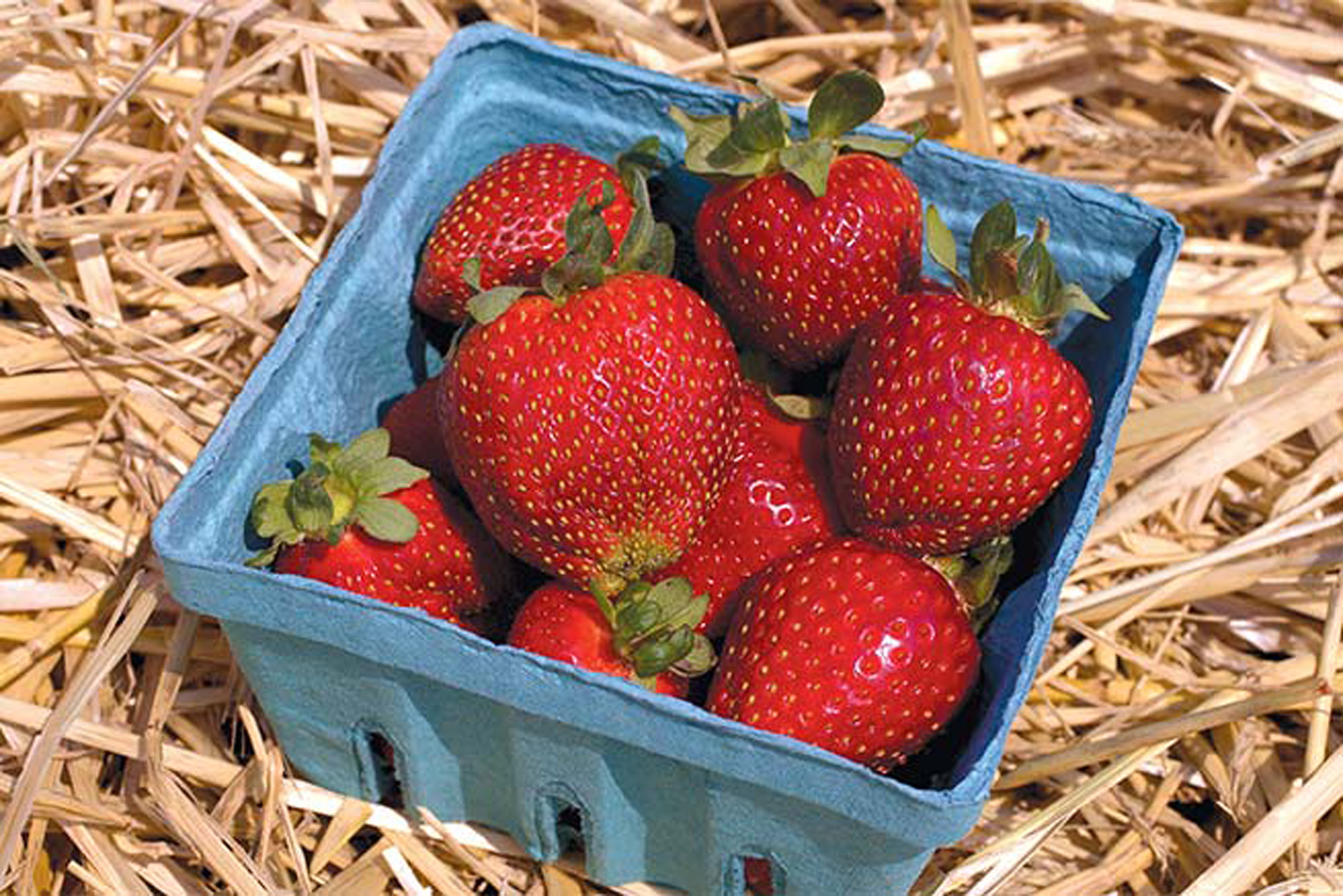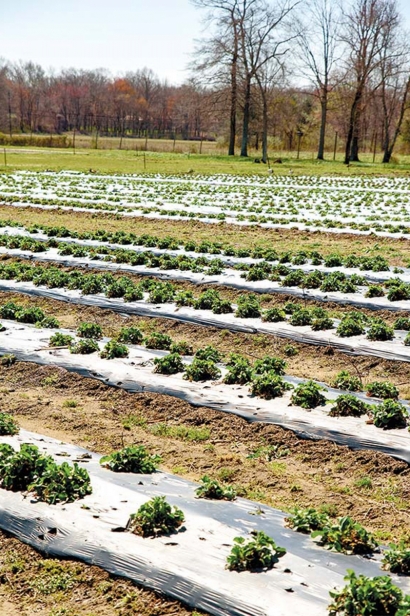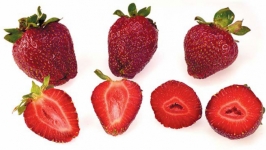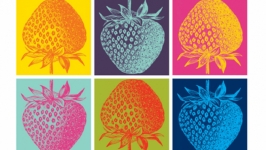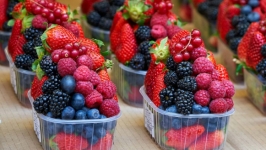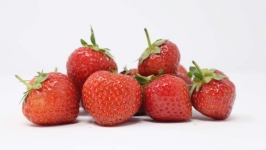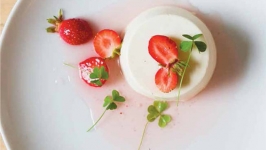Rutgers Scarlet: The Jersey Strawberry
A new strawberry variety, the Rutgers Scarlet, is taking the fields by storm
Photographs by Michelle Montgomery and Peter Nitzsche
If Bill Hlubik has his way, there will be strawberry fields forever— or at least a little longer each year— in the Garden State. Hlubik and his team at the Rutgers New Jersey Agricultural Experiment Station in New Brunswick hope to someday introduce new varieties that will extend the growing season beyond the traditional four weeks for June-bearing strawberries.
For now, however, it’s all about the flavor.
Hlubik, a professor at Rutgers University, is the co-researcher and developer of its newest variety of strawberry, dubbed the Rutgers Scarlet. It was bred to grow well in the state’s wide range of soils and to withstand the dramatic swings in Jersey’s climate. Most strawberries outside of New Jersey, especially California’s, have been developed for durability—how well they tolerate transport across the country on trucks. They were also bred to grow in soils and climates alien to New Jersey. Not so with the Rutgers Scarlet, Hlubik says. It’s pure Jersey. But the main reason the Rutgers Scarlet was developed, Hlubik says, was for its taste: “It was produced for consumers interested in the best tasting strawberries when picked and eaten fresh from the farm.”
The Rutgers Scarlet is sweet, Hlubik says, balanced with just the right amount of acidity. You most certainly don’t need to add sugar, and it tastes like a strawberry, which is an important trait in an era when grocery store strawberries often taste like nothing. The Rutgers Scarlet is also a beauty. It keeps its strawberry red color throughout, with no white middle. By all reports, from professional tasters as well as tasters- on-the-street, the Rutgers Scarlet is proving to be a plant-breeding success story. In a blind taste test of several varieties, the Rutgers Scarlet “came out on top of the list every time,” according to Dr. Beverly J. Tepper of the Department of Food Science at Rutgers University.
The Rutgers Scarlet made its market debut last year—in small quantities, mainly on the 13 New Jersey farms that trialed the strawberry for Hlubik. The development process began, however, about 12 years earlier for Hlubik and his team, and their effort built on professor emeritus Gojko Jelenkovic’s 25 years of work with strawberries before that. In other words, the Rutgers Scarlet is a strawberry 37 years in the making.
No genetic modification was used in developing the Rutgers Scarlet, Hlubik says, only old-fashioned plant breeding techniques—the traditional method of crossing pollen from one flower to another. Once perfected, the Rutgers Scarlet met all their growing goals.
“When we’re trying to develop a new variety,” Hlubik says, “we look for flavor, size, shape, color, yield, post-harvest storage quality and architecture of the plant.”
The Rutgers Scarlet performed exceptionally well in multiple categories: it clocked in with a high Brix rating, which assesses the sugar content; its sweetness was nicely balanced with acidity, which enhances the strawberry’s flavor and gives it depth; its size was good; the yield was good to moderate; and its color was a “very nice” red. But it was over-the-top pure strawberry flavor they were after most. “We believe we have achieved that,” says Hlubik.
One of the 13 farmers who trialed the new berry was Hlubik’s brother, Raymond, who runs the family’s 180-acre conventional farm in Chesterfield. He is no newcomer to trialing for Rutgers. Over the years, he’s tested new pepper and tomato varieties and was more than happy to run a trial with strawberries, beginning three years ago.
The results? Raymond says the Rutgers Scarlet produces well and has great flavor. He upped his original allotment of 150 Rutgers Scarlet plants to 400 this year, so there should be more available for purchase this season. “People asked for them at our farm market,” Raymond reports. “They bought them and came back for more.”
Some farmers, like Raymond Hlubik, are veterans at running trials for Rutgers. Jess Niederer of Chickadee Creek Farm in Pennington, where she grows organic produce on 19 acres, is one of the newbies. Last year was her first time trialing for Hlubik. She found the response to the Rutgers Scarlet to be wildly enthusiastic—her phone was flooded with calls about a special strawberry. “It’s rare for anyone to ask for a fruit or vegetable by name,” Niederer says. “And when it happens, you should give your customers what they want.”
Niederer, who sells at local farmers markets throughout Central Jersey, increased her previous year’s planting of 75 Rutgers Scarlet plants to 1,500 plants this year.
Niederer says that as a commercial farmer she looks for productivity and equal ripening rate, where the whole berry turns ripe at the same time. The Rutgers Scarlet performed adequately enough on both accounts to stay in her farm plan. But it was the strawberry’s “wow” flavor factor that guaranteed its spot. “It has the best flavor that you’re going to find,” she says.
Another young farmer who trialed the Rutgers Scarlet is Stephen Specca of Specca Farms in Springfield. A fourth-generation farmer, Specca is a senior at Rutgers majoring in agriculture, and he and his father trialed the Rutgers Scarlet last year on their family farm. So pleased was he with the Rutgers Scarlet’s performance and flavor that he doubled his plantings for his farm’s pick-your-own strawberry season this year.
“I think it has a more robust flavor than others,” Specca says. “You can taste the flavor as soon as it hits your mouth. It’s in your face. You don’t have to search for it. It’s definitely a strawberry flavor that you’ll remember.”
Mary Lynn Shiles and her daughter, Erica, of The Grasso Girls Farm Market in Mullica Hill, were also first-time trialers. “Oh my goodness,” says Mary Lynn. “The Rutgers Scarlet is absolutely delicious. People drove two hours just to try them.”
Over in Princeton, Gary and Pam Mount, farm owners at Terhune Orchards, also had a good experience trialing the Rutgers Scarlet. “We liked them,” Gary says, “and they had a tremendous consumer acceptance.” Because the Mounts are on a two-year planting system, they won’t have as many as they would like this year at their farm market, he says. You can be sure, however, he’s already planning more Rutgers Scarlet for next year.
Is there no downside to growing this superstar variety? I mention to Pam that I heard the Rutgers Scarlet wasn’t the largest strawberry, nor did it grow the fastest. Not hesitating, she replies, “Is that a negative?”
“The Rutgers Scarlet is the tastiest,” she continues. “If it grew the largest and the fastest, it wouldn’t be the tastiest. Good things take time to grow.”
STRAWBERRIES FROM AFAR
Most strawberries found for sale in supermarkets are grown just about as far from New Jersey as one can get without leaving the continental United States: 83% of the country’s strawberries are grown in California. Most of the rest are grown in Florida.
WHEN TO PICK
The Rutgers Scarlet grows well flat on the ground, in raised beds and even in hanging baskets as long as they are well watered, says Bill Hlubik. For peak flavor, pick the berries early in the morning when the air is cool. If not eating them shortly after picking, store in the refrigerator. Strawberries are ripe when their color turns a uniform red.
STRAWBERRIES IN THE KITCHEN
In her engaging cookbook, Fresh Tastes from the Garden State (Rutgers University Press), Carol Byrd-Bredbenner delivers historical tidbits and practical advice along with her recipes:
- When storing strawberries, she advises, never pile the berries on top of each other. Instead, layer the unwashed strawberries in a container lined with dry paper towels, separating each layer with additional dry paper towels, then cover and place in the fridge. Stored this way, they’ll remain fresh for a few days. Washed berries decay quickly.
- Always serve strawberries at room temperature. If refrigerated, remove at least one hour before serving, give them a quick rinse, pat dry and remove the green caps, either with a light twist or the tip of a sharp knife.
- To freeze, place dry, unwashed, hulled strawberries in airtight freezer containers or plastic bags. Alternatively, she says, lay them on a shallow pan with sides and place in the freezer. When frozen solid, plop them into airtight containers or plastic bags. Press out air and seal tightly before returning to the freezer. Just before using, rinse the frozen berries and pat dry.
WHERE TO BUY RUTGERS SCARLET STRAWBERRY PLANTS
Rutgers Scarlet strawberry plants will be available for purchase August 20, 2016 (August 21 rain date), from 11am to 3pm at Rutgers Cooperative Extension of Middlesex County, 42 Riva Drive, South Brunswick (GPS is North Brunswick). The commercial grower Nourse Farms in Massachusetts (noursefarms.com) will also have Rutgers Scarlet strawberry plants available for sale to home gardeners next spring. Due to the overwhelming demand, Nourse sold out of the Rutgers Scarlet this year, but will be doubling its planting for 2017.
SOME JERSEY FARMS EXPECTED TO SELL
RUTGERS SCARLET STRAWBERRIES THIS YEAR:
- Alstede Farms, Chester
- Budds KnP Farms & Country Market, Pemberton
- Byrne Farm Market, Wrightstown
- Catalpa Farm, Princeton
- Chickadee Creek Farm, Pennington
- Donaldson Farms, Hackettstown
- Giamarese Farm & Orchards, East Brunswick
- Grasso Girls Farm Market, Mullica Hill
- Happy Valley Berry Farm, Bridgeton
- Hauser Hill Farm, Old Bridge
- Hlubik Farms, Chesterfield
- Meadows Edge Alpaca Ranch & Market, Port Norris
- Ort Farms, Long Valley
- Phillips Farms, Milford
- Pop’s Farm Market & Garden Center, Monroe Township
- Russo’s Orchard Lane Farm, Chesterfield
- Silverton Farms, Toms River
- Snyder’s Farm, Somerset
- Sparacio Farms, Bridgeton
- Specca Farms, Bordentown
- Summer Wind Farms, Newfield
- Terhune Orchards, Princeton
- Wemrock Orchards, Freehold
- Wus Farm, Howell


